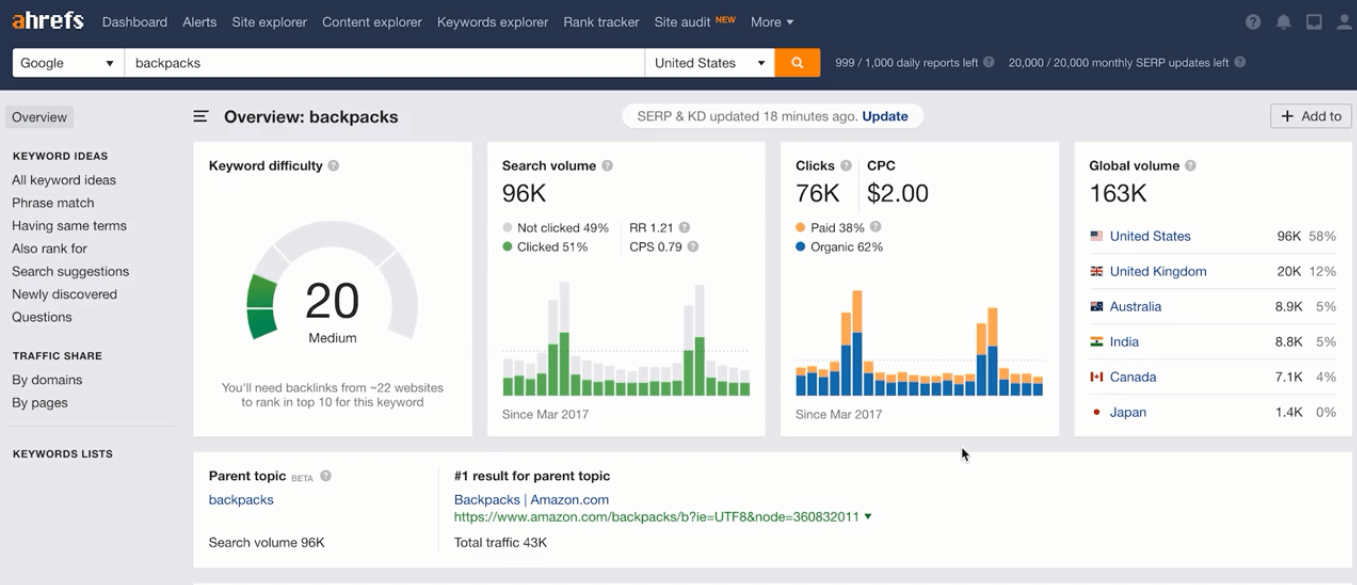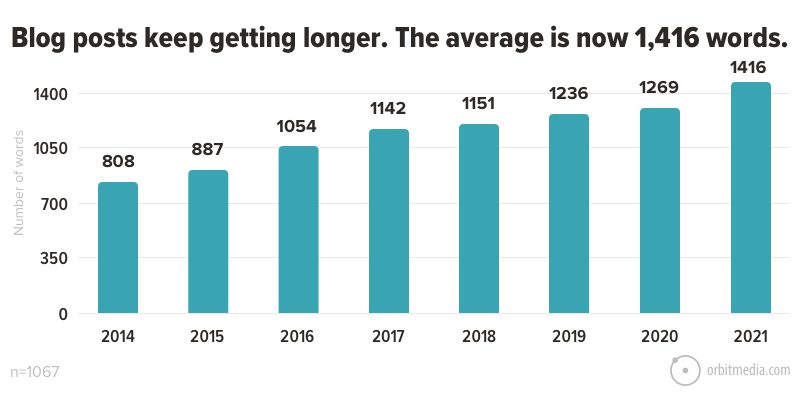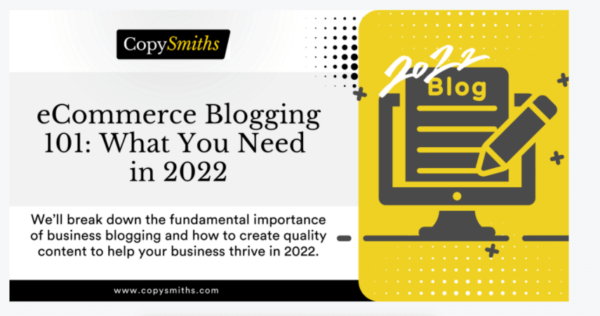Running an eCommerce store often means you constantly have your hands full. From sourcing products and managing inventory to fulfilling orders and providing customer support.
But even so, you can’t afford to ignore the impact of running an active and engaging blog on your eCommerce website.
In fact, the survival and success of your store heavily depend on your ability to leverage your eCommerce blog.
How so? Well, today, we’ll break down the fundamental importance of business blogging and how to create quality content to help your business thrive in 2022.
Specifically, we’ll take a look at:
- The role of SEO in eCommerce blogging
- How eCommerce blogging helps build authority
- Focused content, and how it improves leads
- How to drive conversions through content
1: The Role of SEO in eCommerce Blogging
Search engine optimization (SEO) refers to the art and science of enhancing your website to improve the quantity and quality of organic traffic you receive. .
For your eCommerce blog to succeed and to significantly improve the performance of your blog, you need some understanding of SEO content.
Here are two essential SEO principles to start you off:
I. Search Intent
Google and search engines care a lot about accurately resolving search intent. That is, to provide content that clearly and authoritatively answers user queries.
Therefore, your goal should be to identify and create content around your target audience’s search intent.
II. Keywords
You need to be strategic when using keywords and semantically related phrases in your blog.
Find keywords with relatively low ranking difficulty and high search volume within your niche and build authoritative content around them to boost your ranking.
To do this, you can use tools like Ahrefs, Moz, or SEMrush.
Here’s a screenshot of what using Ahrefs keyword research looks like:

Blog content infused with the right keywords helps search bots better understand what your content is about. As a result, this boosts your rankings on that topic and consequently improves organic traffic to your website.
Expert Tip: If you write a high-quality article that stays focused on your primary keyword, then you naturally pick up enough of the semantically related words and phrases.
2: How eCommerce Blogging Builds Authority
Google favors pages with authority. In terms of eCommerce blogging, this can mean many things, some of which are beyond your control. Thankfully, there are two key authority components you can control:
I. The Length of Your Blog Posts
Google favors long-form content. The exact length depends on the topic and what the competition is doing.
What’s clear though, is that 500-word blog posts don’t cut it anymore.

“… when it comes to Google rankings, social shares, and backlinks, longer content tends to outperform short blog posts.”
-Brian Dean, Co-founder of Exploding Topics
Strive to create longer content, or at least match what the competition is doing.
Longer content allows you to write with more depth, further building authority and improving your chances of ranking higher on search engine results pages (SERPs).
II. The Quality of Your Blog Posts
Google’s algorithms are now advanced enough to distinguish between well-written and poorly written blog content.
The good news is that the quality of your blog content is entirely in your control.
For example, you can start by ensuring that your grammar is unimpeachable and vary your vocabulary and sentence length.
You can also infuse your blog content with varied media and visual assets—all features that Google loves and considers signs of high-quality content. These include:
- Images and videos
- Tables and charts
- Social proof
- Illustrations
- Lists
In addition to building authority with search engines, you also need to build authority with your readers and target audience.
Fortunately, this is relatively easy to do—use your blog to share relevant and factual advice, tips and tricks, tutorials, and industry news and knowledge.
This guide on removing hair extensions is a perfect example:

If you consistently publish valuable content that resonates with your audience, you earn their trust in your brand and set yourself as an authority and thought leader in your niche.
Related: 5 Undeniable Benefits of Blog Content for eCommerce Stores
3: Focused Content and Lead Generation
It’s assumed that the primary goal of blogging is to increase page views and site visits. However, what you really want are leads and customers, not random visits.
Creating focused content helps you draw in strong prospects with the intent of turning them into customers.
Below are two effective ways to create focused content for your eCommerce blog:
I. Create a Buyer Persona
Creating a buyer persona based on market research and data about existing customers will help you generate better content targeted at your ideal customers.
The key points you should consider when creating your buyer persona are:
- Demographics: These include variables such as age, gender, geographical location, and level of education.
- Customer activities: Specifically their behavior patterns across multiple platforms, including your website, live chats, social media platforms, and email.
This information will help create a more accurate representation of your ideal customer and, consequently, more effective blog content.
II. Target Visitors at Different Buying Stages

Other than focusing on the right topics, you need to target website visitors at different stages of their buyer journey.
Remember, different types of blog content achieve different goals.
For instance, content that helps draw visitors to your eCommerce blog won’t necessarily convince them to make a purchase.
Typically, your blog is a place to house your ‘awareness’ content. That is, content that educates and entertains your audience without being too promotional.
This kind of content builds trust with new visitors who’ve landed on your website for the first time, whether through search engines or social media links.
Once your audience is aware, you can use ‘branded’ content to introduce them to your products without coming off as too salesy. You can do this by subtly plugging your products in your educational posts, showing them that your products and services are great and can solve their problems.
Expert Tip: Unless you’re announcing a new product, your eCommerce blog should never contain overly promotional content. Limit that to your product descriptions and social media pages.
Related: 3 Article Types To Boost Your Site Traffic
4: How to Drive Conversions Through Content
Creating amazing eCommerce blog content is only half the battle. Even with the most entertaining content, you still need to actively promote it to start receiving traffic and conversions.
Here are three ways you can use content to drive conversions:
I. Harness the Power of Social Media
With hundreds of millions of pieces of content shared across social media every day, leveraging social media is a surefire way to increase visits to your eCommerce website.
Share your blog posts on social media using your personal and brand accounts. Spread out the posts to ensure they get the maximum possible readership from followers.
You can take this a step further by running ads on social media platforms like Facebook and Instagram.
II. Create and Grow Your Mailing List
As of March 2021, there were over 3.9 billion daily email users. This number is expected to grow to 4.6 billion by 2025.
If you use it right, your email list will become your biggest source of traffic.
This is because email marketing helps nurture a one-to-one relationship with potential customers through personalized marketing.
Email marketing also helps convert guests who stumbled onto your blog looking for information. It keeps them in the funnel, actively marketing to them until they’re ready to convert.
Here are some tips you can use to grow your email list:
- Incorporate in-line opt-in forms to your blog.
- Create newsletters promising alluring content and deals.
- Offer gated content in exchange for email addresses.
III. Use Pop-Ups Wisely
Pop-ups are a highly effective way to collect your visitors’ email addresses and convert them into leads.
But with great power comes great responsibility—pop-ups can also be pesky and pushy. As such, you need to be careful when using them to achieve the desired effects.
To that end, here are the dos and don’ts of pop-up use.
| Pop-up Dos | Pop-Up Don’ts |
|
|
Related: 6 New Reasons to Outsource Content Writing
Unlock Your Blog’s Full Potential
Creating quality eCommerce blog content is no easy feat. For a time-strapped business owner, the process and time it takes to tap into the full potential of your blog can seem overwhelming.
Thankfully, there’s an easier and more effective way—outsource your eCommerce blogging to a capable, reputable content shop such as CopySmiths.
At CopySmiths, we create high-quality blog content at scale for businesses that need regular and reliable articles.
With a specialized and dedicated team and over 20 years of experience in eCommerce, we can help you realize your blog’s full potential.
But don’t take it from us:
“…their approach is strategic and SEO results-driven…their transparent use of SEO tools to ensure their content is competitive was really impressive…” Chris, Red Kite Design
“We’ve used many content writing services, and Copysmiths was by far the most responsive and organized.” Eric Thomas, CRD Design Build
“Lodge has seen a 103% increase in our Organic Search traffic this month as a direct result of working with the CopySmiths” Paul Napper, Lodge
So if you’re ready to unlock your eCommerce blog’s full potential, contact us today.
Share on LinkedIn:

